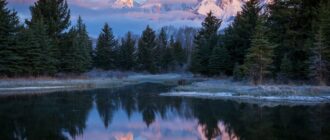History of the Area
Keystone Lake was named after the community of Keystone, a post office from 1900-1962. The name stems from the circumstance that the original site, inundated by the waters of the lake, was in a key position at the Junction of the Cimarron and Arkansas Rivers. The, former townsites of Mannford, Prue, Appalachia, and part of Osage also were abandoned because they were in the lake area. Mannford, which took its name from Mann’s Ford across the Cimarron River adjoining the townsite, was relocated southward and Prue northward out of reach of the lake water. At Cleveland, established shortly after the opening of the Cherokee Strip in 1893, the Corps of Engineers protected low-lying areas with a levee that rims the south and east sides of the city.
In the old days the Triangle Country- the land between the Arkansas and the Cimarron-was full of wild game: buffalo, deer, bear and turkey. The Osage Reservation was to the north, bordered by the Arkansas River, and the Creek Reservation lay just to the south.
A major American explorer made a journey up the Arkansas River from Fort Smith and into the valley of the Cimarron River in the spring of 1819. He was Thomas Nuttall, a professor of botany at Harvard, who studied the plants and flowers of the region.
Washington Irving, noted American writer, and his companion, John Joseph Latrobe, an English traveler who wrote “The Rambler in North America,” visited the country around Keystone Dam in 1832. They accompanied a detachment of Rangers — mounted infantry from Fort Gibson on a tour of exploration of the western wilderness. In his book, “A Tour on the Prairies,” Irving wrote of their overnight camp in Bear’s Glen about 1 mile north of the Keystone Dam.
Camp Arbuckle was established in 1834 near the Junction of the Cimarron and Arkansas Rivers. It was one of three outposts established to protect the Leavenworth Expedition that set out in June 1834, for the Wichita Mountains. The object of the expedition was to stop a war that had broken out between Osage and smaller tribes of Plains Indians.
Many other famous names are associated with the Keystone area. Captain Nathaniel Boone, son of Daniel, led troops through here on their way to the High Plains, in 1843. A famous lawman, U S Marshall Nix chased outlaws into the area’s hills and caves.
The project was authorized by the Flood Control Act of 1950. It was designed by the Tulsa District, U S Army Corps of Engineers and built under supervision of the Corps.
Construction of the dam began in December 1956 and was completed for flood control operation in September 1964. Commercial operation of the Keystone powerplant in the production of electrical energy began in the spring of 1968. A reregulating dam about 7 miles downstream from the dam was completed in 1968. Cost of overall construction was approximately $123 million.
Safety Message
Keystone Lake has numerous underwater hazards. Be especially watchful for submerged stumps, logs, particularly in shallow water and along shoreline.
Sudden swift rises may occur when water is being released for power. A horn will sound when water release begins and red lights will blink during the time water is being released. Heed the warning.
Accessibility
The restrooms at Salt Creek North Park and New Mannford Ramp Park are wheelchair accessible, as well as the fishing berm in Brush Creek Park and on the North side of the river below the dam.
Washington Irving Park, New Mannford Park, and Salt Creek North Park have handicap accessible bathrooms.
Cowskin Bay South Park, Salt Creek North Park, and New Mannford Ramp Park have boat docks for loading and unloading by the physically challenged.
Pertinent Data
Authorization: Flood Control Act approved 17 May 1950, Project Document SD 107, 81st Congress, 1st Session.
Location: On the Arkansas River at river mile 538.8, about 15 miles west of Tulsa in Tulsa County, Oklahoma.
Purpose: Flood control, water supply, hydroelectric power, navigation, and fish and wildlife.
Status: Complete.
History of Construction: Construction began in January 1957 and the project was placed in flood control operation in September 1964. The number 2 generating unit became operational on 2 May 1968 and the number 1 generating unit became operational on 21 May 1968.
Type of Structure: The embankment is constructed of rolled earthfill material. The total length of the dam, including a 1,600-foot-long concrete section, is 4,600 feet. The maximum height is about 121 feet above the streambed. The concrete section consists of a spillway 856 feet wide, a non-overflow section, and a power intake structure. Highway 151 crosses the dam to connect relocated U.S. Highway 51 on the south with relocated U.S. Highway 64 on the north.
Spillway and Outlet Works: The spillway is a gated, concrete, ogee- weir with a net width of 720 feet, surmounted by eighteen 40- by 35- foot tainter gates. Spillway capacity at the top of maximum pool (elevation 766.0) is 939,000 cfs and at the top of the flood control pool (elevation 754.0) is 565,000 cfs. The spillway is also equipped with nine 5.67- by 10-foot sluices located between alternate intermediate piers. Channel capacity of the Arkansas River below Tulsa, Oklahoma, is about 90,000 cfs.
Power Intake Structure: The powerhouse and power intake structure are located between the spillway and the left non-overflow sections and include two penstocks, each 27 feet in diameter, controlled by two 14- by 30-foot gates.
Hydrologic Data: The flood of record occurred 29 September to 21 October 1986 and had a volume of 4,444,000 acre-feet, which is equivalent to 3.73 inches of runoff. Peak inflow to the lake was 344,000 cfs.
Lake Data: Based on 1988 sedimentation survey.
| Feature | Elevation (feet) | Acres | Capacity (acre-feet) | Equivalent Runoff (1) (inches) |
| Top of Dam | 771.0 | |||
| Top of Gates and Flood Control Pool | 754.0 | 54,678 | 1,672,613 (2) | 1.40 |
| Flood Control Storage | 723.0-754.0 | 1,167,232 | 0.98 | |
| Top of Power Pool | 723.0 | 22,420 | 505,381 | 0.42 |
| Power Storage | 706.0-723.0 | 278,122 (3) | 0.23 | |
| Spillway Crest | 719.0 | 18,832 | 423,483 | 0.36 |
| Bottom of Power Pool | 706.0 | 12,430 | 227,259 | 0.19 |
|
(1) Runoff from contributing basin area of 22,351 square miles. Total |
||||
Power Data:
| Item | Amount |
| Required Flow for Seasonal (June to September) Continuous Power, average cfs | 1,120 |
|
Average Net Power Heads, feet |
|
| Power Pool, full | 86 |
| Power Pool, empty | 66 |
| Average | 81.5 |
| Seasonal (June to September) Continuous Power, kW | 6,400 |
| Installed Capacity (two 35,000-kW units), kW | 70,000 |
|
Annual Firm Energy Output, kWh (based on original capacity) |
|
| Primary | 43,000,000 |
| Secondary | 185,000,000 |
| Total | 228,000,000 |






